Artist and gallerist Nick Lawrence was the sole juror for the show “Departures,” currently on exhibit at the Cape Cod Museum of Art in Dennis. Lawrence selected 53 works from the 520 submissions for the group show. The museum sent out an international call for artworks that either exhibited a moment of departure from conventional norms and styles in the art world or a departure from the artist’s usual practice.
Lawrence owns the Readymade Gallery in Orleans and the gallery Freight + Volume in New York. He owned and operated DNA Gallery in Provincetown for 15 years.
“Since I was not familiar with all the individual artists’ previous work and how it related to a departure in their new work,” Lawrence says in the exhibition catalogue, “I focused on the work which best exemplified the notion of departure — in terms of innovation, striking imagery, unusual palette or fresh technique, the leaps and bounds of individual artistic expression.”
Benton Jones, director of art for the museum, curated the exhibit. Submissions came from 35 U.S. states and seven other countries: Canada, England, Spain, Denmark, India, China, and Latvia. The final exhibit includes 40 two-dimensional works, 11 sculptures, and two videos.
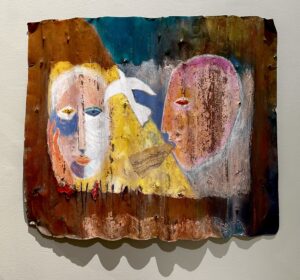
“It is a departure for a smaller museum on Cape Cod to have artwork that pushes the envelope,” says Jones, “to have a more urban, contemporary selection.”
Jones says he laid out the navigation for the exhibition in groupings by abstractions, landscapes, or figurative works. “You’ll see there are certain themes you’ll pick up on in different areas,” he says. “There’s quite the range, from 3D printed sculpture to video, to writing and imagery in book format, photography, fabric art, digital art, painting, and prints.”
Orleans artist Thomas Hoffman won first prize for his oil painting When We Thought We Saw an Owl on the Patio. “Nick loved the color palette, composition and the mystery behind it — the unresolved, the owl staring at you, the figure, the long shadow,” says Jones. “He mentioned the Eurasian eagle owl Flaco who escaped from the Central Park Zoo this year and ended up dying. He was wondering if that’s why an owl was included, but the viewer must provide answers.”
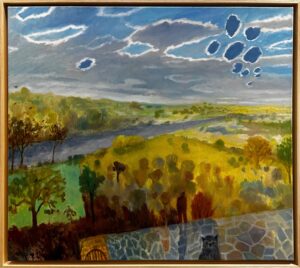
Mornings at Sunshine by Barnstable artist Hugo Rizzoli is an assemblage of reclaimed wood pieces and buoy rope. Jones said a group of kids came out of the classroom in the back of the museum one day and ran right to that piece. Rizzoli described his work to Jones as a collage in wood. It deals in bright colors and simple rectangular or triangular pieces.
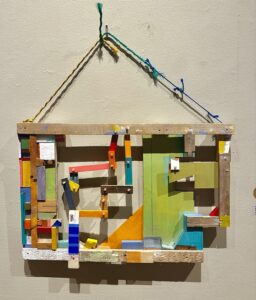
But each piece has a different depth, and absences create a sense of dimension. Floating ladders are held together by wood pegs in the center of the piece. A little cat hair hangs off a found wood block painted with orange acrylic. The number 16 is written in pencil on an unpainted cut wood rectangle.
Providence artist Jerold Ehrlich’s sculpture Offer Up Your Prayers uses steel and wood. The sculpture doubles as an incense burner. A steel staircase makes its way up to a small house that hangs in the air. Atop the house’s chimney is an animal-like head piece. The sleek staircase invokes fear and sexual discovery — something soon to burn.
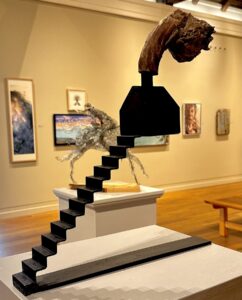
Orleans artist David Holbrook’s sculpture Burner Phone uses wood and flickering blue LED lights. A long narrow wood rod meets a cell tower on a diagonal. The rod skewers the wood cell phone that sits in the center of a wood disc, lit by the blue LED light.
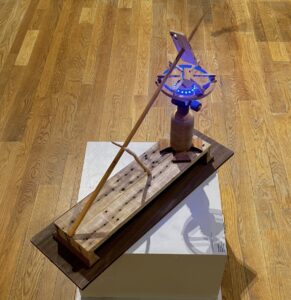
“He was considering something primal — roasting a burner phone over a fire of blue lights — a primal action done with contemporary technology,” says Jones.
“There’s even a magic mushroom on the wall, which is a pretty literal departure,” says Jones about The Fun Guys, an acrylic and clay work by South Carolina artist Holly Barr.
Dennis artist Patricia Barnes’s oil painting Missing You is about loss. The upper body of the figure on the left is blurred into the horizon — only the legs and feet have definition. They are moving toward the water line. A gray-haired woman in a bikini holds a red balloon on the right side of the canvas, while the green balloon on the left has no hand holding it. The green balloon may mean “Go,” as in depart.
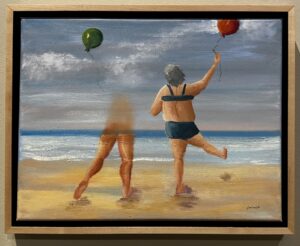
“As I began to paint the left figure — it went in an entirely different direction,” writes Barnes in her wall text. “It had a mind of its own.”
“Eve Aspinwall went to the Caribbean and didn’t have anything to paint on, so she found corrugated metal and painted on that,” says Jones. Lost Song, Aspinwall’s 1999 mixed-media work on found Caribbean zinc, features a white bird flying between two faces. One face has a torn sheet of music coming out of its mouth. The bird cuts the sky in two. A bright orange hand cups the blue cheekbone of the face on the left. Although the face has no ears, the eyes appear to be listening.
Inguna Gremzde’s Small World is 35 bottle caps arranged in rows of seven. Five caps are red, 12 are green, and 18 are blue. Each cap is the same size and has a different oil landscape painting inside it. Every painting is different: some have trees, and some are of the sky above the tree line.
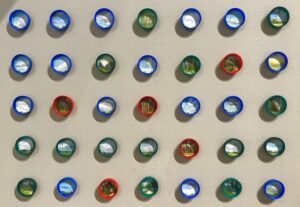
Truro artist Cole Cook’s Hibernation uses a shadowbox, medium-density fiberboard, and plywood. The subject is a figure with its hand over its head. There is a foot at the far left. The carved wood and the shadowbox give the piece depth and form, “wrapped up and twisted,” says Jones.
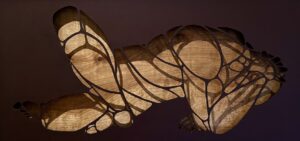
“The whole year we have had movement and transportation as themes here at the museum,” says Jones. “The ‘Departures’ exhibit also has a theme that’s going somewhere.”



